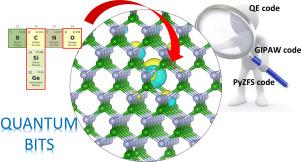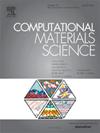First-principles studying for quantum defects in cubic boron nitride
IF 3.1
3区 材料科学
Q2 MATERIALS SCIENCE, MULTIDISCIPLINARY
引用次数: 0
Abstract
The quest for novel solid-state quantum bits (qubits) is pivotal in the development of next-generation quantum technologies. In this study, employing first-principles simulations based on density functional theory, we have scrutinized the quantum defect properties of four complex defects within cubic boron nitride (cBN) crystals; they are formed by a Boron vacancy and an adjacent impurity—where the impurity atom can be either an Oxygen substituting a Nitrogen, or a Carbon, Silicon, or Germanium substituting a Boron. We assess key qubit-related parameters including the zero-phonon line, zero-field splitting, and hyperfine interaction, and compare our findings with both experimental data and previous theoretical studies. Our results indicate that these defects exhibit significant promise as quantum bits, potentially surpassing the capabilities of the nitrogen–vacancy complex center in diamond, particularly in the context of quantum networks or bio-nanosensors that leverage telecom wavelength quantum emissions. Furthermore, we have conducted an analysis of the thermodynamic stability of these defects and proposed possible strategies to enhance their stability in experimental settings. The collective insights gained from this study pave the way for more adaptable strategies in the design and engineering of quantum bits in cBN for advanced quantum technologies.

立方氮化硼量子缺陷的第一性原理研究
对新型固态量子比特(量子位)的探索是下一代量子技术发展的关键。在这项研究中,我们采用基于密度泛函理论的第一性原理模拟,仔细研究了立方氮化硼(cBN)晶体中四个复杂缺陷的量子缺陷特性;它们是由一个硼空位和一个相邻的杂质形成的,其中杂质原子可以是取代氮的氧原子,也可以是取代硼的碳原子、硅原子或锗原子。我们评估了与量子比特相关的关键参数,包括零声子线、零场分裂和超频相互作用,并将我们的发现与实验数据和以前的理论研究进行了比较。我们的研究结果表明,这些缺陷有望成为量子比特,有可能超越金刚石中氮空位复合中心的能力,特别是在利用电信波长量子发射的量子网络或生物纳米传感器方面。此外,我们还对这些缺陷的热力学稳定性进行了分析,并提出了在实验环境中增强其稳定性的可能策略。从这项研究中获得的集体见解为在先进量子技术的 cBN 量子比特设计和工程中采用更具适应性的策略铺平了道路。
本文章由计算机程序翻译,如有差异,请以英文原文为准。
求助全文
约1分钟内获得全文
求助全文
来源期刊

Computational Materials Science
工程技术-材料科学:综合
CiteScore
6.50
自引率
6.10%
发文量
665
审稿时长
26 days
期刊介绍:
The goal of Computational Materials Science is to report on results that provide new or unique insights into, or significantly expand our understanding of, the properties of materials or phenomena associated with their design, synthesis, processing, characterization, and utilization. To be relevant to the journal, the results should be applied or applicable to specific material systems that are discussed within the submission.
 求助内容:
求助内容: 应助结果提醒方式:
应助结果提醒方式:


